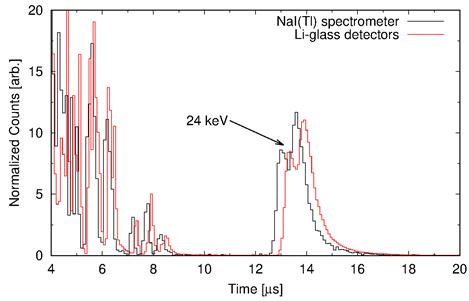Neutron beam filter system for fast neutron cross-section measurement at the ANNRI beamline of MLF/J-PARC
2021.07.12
Highlights
- A neutron filtering system has been introduced in the neutron beamline ANNRI (Accurate Neutron–Nucleus Reaction Measurement Instrument) of the Japan Proton Accelerator Research Complex (J-PARC) in order to produce quasi-monoenergetic neutron beams.
- The filtered neutron beam by the filter system enables accurate neutron cross-section measurements in the keV-neutron region.
Summary
A neutron filtering system was implemented at the ANNRI beamline to bypass the double pulse structure of the neutron beam. Silicon and iron were chosen as filter materials. Both Si and Fe filters provide sharp well-defined energy neutron peaks. Three neutron filter assemblies consisting of 20 cm of Fe, 20 cm of Si and 30 cm of Si were tested in ANNRI by means of capture experiments and transmission experiments. The incident neutron spectra through the filtering system were measure by the time-of-flight (TOF) method [term 1]. In addition, the experimental results were accurately reproduced by Monte Carlo simulations with the PHITS code. Finally, the 197Au neutron capture cross-section was measured using the filtering system. The experimental results of the cross section agree with the evaluated data from JENDL-4.0 within uncertainties.
Background
The recent development of intense pulsed neutron facilities employing spallation neutron sources [term 2] has allowed for the measurement of neutron-induced reactions, namely neutron capture, using small amounts of sample. The ANNRI beamline in the Materials and Life Science (MLF) experimental facility of J-PARC provides one of the most intense neutron beams currently available and was thoroughly designed in order to measure neutron-induced reactions with high accuracy. However, the J-PARC accelerator is operated in a double-bunch mode in which two proton bunches are injected into the spallation target with a time difference of 600 ns. Events detected with a specific TOF have two different energies as they could have been originated from each of the two different proton pulses. In order to bypass the doublet structure of the neutron beam, a neutron filtering system was designed, built and tested in the present work.
Experiments
Fe and Si filters were designed. The filters consisted of stacked cylinders. Each cylinder has a diameter of 10 cm and a thickness of 5 cm. The filters were introduced upstream of Experimental Area 1 of ANNRI. For Fe, the total thickness was 20 cm. In the case of the Si filter, the two configurations, 20 and 30 cm in thickness, were tested.
Measurements with the NaI(Tl) spectrometer of the ANNRI beamline were employed to obtain the time distribution of the filtered neutron beam. The energy dependence of the incident neutron beam was determined by measuring the 478-keV gamma-rays from the 10B(n, αγ)7Li reaction using a boron sample with calculations with the PHITS simulation code. Transmission measurements were also carried out to assess the performance of the filtered assemblies. Li-glass scintillation detectors were employed in the measurements.
Results
An obtained incident neutron TOF spectrum through the 20-cm Fe filter is shown in Fig. 1. A peak of 24-keV neutron was clearly observed. Good agreement between the two detectors, NaI(Tl) and Li-glass scintillators can be seen. The difference in time is due to the difference in neutron flight length. Using this quasi-monochromatic neutron beam, measurement of neutron reaction cross sections in the keV region is now possible. We plan to measure the neutron capture cross sections of minor actinides that have been difficult to measure.
This work was supported by MEXT Innovative Nuclear Research and Development Program. Grant Number: JPMXD0217942969.

Fig. 1 Incident neutron spectrum through 20 cm Fe filter.
Glossary
- [Term 1] Time-of-flight method:
- A method to measure the energy of neutrons. The neutron energy is determined by measuring the time of flight of a neutron over a certain distance.
- [Term 2] Spallation neutron source:
- When a particle of high energy in the order of GeV collides with an atomic nucleus, a spallation reaction occurs that breaks the nucleus into pieces. The spallation reaction produces a large number of neutrons, and is used as an efficient way to generate neutrons. Spallation neutron sources are being operated and constructed in many countries around the world to produce high-intensity neutron beams.
Journal information
- Journal :
- Nuclear Instruments and Methods in Physics Research, A 1003, 165318 (2021).
- Title:
- Neutron beam filter system for fast neutron cross-section measurement at the ANNRI beamline of MLF/J-PARC
- Author :
- Gerard Rovira1), Atsushi Kimura1), Shoji Nakamura1), Shunsuke Endo1), Osamu Iwamoto1), Nobuyuki Iwamoto1), Tatsuya Katabuchi2), Kazushi Terada2), Yu Kodama2), Hideto Nakano2), Jun-ichi Hori3), Yuji Shibahara3)
1) Department of Nuclear Science and Engineering Directorate, Japan Atomic Energy Agency
2) Laboratory for Advanced Nuclear Energy, Institute of Innovative Research, Tokyo Institute of Technology
3) Institute for Integrated Radiation and Nuclear Science, Kyoto University

